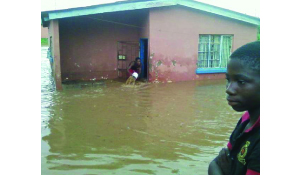By WILLIAM NGULUWE –
ZAMBIA has experienced a number of climatic hazards and extreme events that represent significant departures from the average state of climate system.
Occurrence of extreme events along with their intensity and magnitude have been increasing, the most serious ones being drought, seasonal floods and flash floods, extreme temperatures and dry spells.
Currently, extreme rains are increasing significantly across the country.
The Zambia Meteorological Department (ZMD) in its rainfall forecast for the 2016/2017 period gave stark warning that some areas in the country would experience heavy rains coupled and flash floods.
“The 2016/2017 seasonal rainfall forecast is largely expected to be influenced by the La Nina conditions over the Equatorial Pacific conditions. For Zambia, this condition is most characterised by normal to above normal rainfall performance,” acting director of Meteorology Joseph Kanyanga said in the rainfall forecast statement.
The flash flood guidance monitor published on January 3, 2017 showed a 50 per cent probability of flash flood occurrence in districts that include Lusaka, Chipata, Chadiza, Livingstone, Mazabuka, Monze, Choma, Kazungula, Katete, which were on the ‘Warning’ list.
Kasama, Chinsali, Mumbwa, Serenje, Mkushi districts were on ‘Alert’and the rest of the country was put on ‘Watch’ with a 25 per cent likelihood of flash flood occurrences.
The abnormal rains are causing floods of which at the moment have become a visible sight in some parts of the country.
Lack of proper running water channels to direct rain waters to rivers, dams and other water reservoirs, are a contributing factor to increasing flash floods in Zambia.
Minister of Water development, Sanitation and Environmental Protection, Loyld Kaziya, recently said there was need to work on drainages to avoid these floods.
ZMD has reported that five provinces have been badly affected by floods. The recent outlook projected increased rainfall activities over the eastern half of Zambia.
In Southern Province, continued heavy down pours ravaged maize fields and property for more than 500 families.
Chief Government spokesperson Kampamba Mulenga, who visited the areas, assured the affected families that Government would come to the aid of victims.
“We have a responsible Government to address the issues in the affected areas so that people could be assisted. It is sad that the situation is this bad,” Ms Mulenga said during a tour of the affected area.
Though not highlighted much, the Copperbelt Province is also affected.
The Disaster Management and Mitigation Unit (DMMU) said the Copperbelt had not been spared by flash floods and the situation was worst in slum areas.
DMMU Copperbelt regional coordinator, Edwin Muyunda said during this rainy season, it was the same old story where his office was receiving reports from usual prone areas which were shanty townships being affected by heavy down pours and flooding.
Mr Muyunda said floods where prevalent in slum areas like Kapoto and Mulenga in Kitwe, Chipulukusu and Twapia in Ndola, due to poor drainage systems synonymous with unplanned settlements.
“We started receiving reports beginning the early weeks of January that heavy downpours were wrecking havoc by destroying houses, some roofs were blown off and there was a lot of flooding.
“In Mulenga and Twapia townships 43 houses were badly damaged.
As DMMU we came in and gave some relief to the badly affected houses.
We gave iron sheets, foodstuffs like mealie-meal, cooking oil, and beans,” he said.
Among other severe flood disasters that the Copperbelt DMMU has responded to in the recent past include but not limited to washed away public infrastructure and damaged drainages such as Misaka and Mutupa bridges in Kitwe; Chikangaumo bridge in Kalulushi; Buntungwa bridge in Luanshya; Lwankuni bridge in Masaiti; Kapupulu bridge in Luanshya and drainages in Mushili’s township of Ndola.
On the Copperbelt, disasters associated with flood hazards have been caused by river flooding from heavy or severe rainfall, sometimes associated with hailstorms which can destroy crops and buildings.
In addition, human manipulation of watersheds like farming along river banks and cutting trees which hold water at stream-and river-sources, drainage basins and flood plains have also exacerbated floods and their negative effects.
“As you may be aware, flood hazards impact on both individuals and communities, and have social, economic, and environmental consequences. The consequences of floods on the Copperbelt Province, both negative and positive, vary greatly depending on the location and extent of flooding, and the vulnerability and value of the natural and constructed environments they affect,” he said.
The impact that floods pose on the affected communities when bridges have been washed away mainly include hindering people of the affected community from accessing amenities such as schools, health care centres, markets .When people’s crops have been damaged by floods, food security is affected.
Experts have said that floods wipe out food crops and wash away faecal matter from sanitation facilities into drinking water sources.
Under-nutrition weakens the immune response system of the affected individuals and thus makes them susceptible to infectious diseases.
As most people are well aware, the immediate impacts of flooding include loss of human life, damage to property, destruction of crops, loss of livestock, and deterioration of health conditions owing to waterborne diseases.
As communication links and infrastructure such as power plants, roads and bridges are damaged and disrupted, some economic activities may come to a standstill, people are forced to leave their homes and normal life is disrupted.
This is to say that damage to public infrastructure such as bridges and drainages also causes long-term impacts, such as disruptions to supplies of clean water, wastewater treatment, electricity, transport, communication, education and health care.
As it were, loss of livelihoods, reduction in purchasing power and loss of land value in the floodplains can leave communities economically vulnerable.
It is obvious that flood hazards also traumatise victims and their families for long periods of time especially those whose households have been directly affected. In an event of death, the loss of loved ones has deep impact, especially on children.
Displacement from one’s home, loss of property and disruption of business and social affairs can cause continuing stress. For some people the psychological impact becomes long lasting.
In view of the continuous disaster threats experienced in the country, the Government has been putting together permanent response mechanisms to address the threats.
Mr Muyunda said with the objectives of the department in mind, DMMU team rises to promote and support a comprehensive, development-based set of activities aimed primarily at increasing disaster resilience among populations at risk and ensures that adequate measures are put
in place to prevent the occurrence of or deal with disasters when they occur through efficient and effective response mechanism.
He said in disaster preparedness, actions were taken to safeguard lives and property in a timely, effective and orderly manner through the following three successive phases: when disaster threatens; while hazard conditions which might result in disaster actually prevail; and during the immediate aftermath.
He said the main activities during Disaster Response were tailored towards ensuring quick, timely and effective actions by activating and making operational the response capacity within acceptable reaction time to save lives and property during any disaster situation.
“In order to build capacity for disaster prevention, actions and measures are taken to avoid, eliminate, prevent or reduce the impact of adverse effects and/or hazards from causing or resulting in a disaster.
“The process of prevention is therefore, directed at the formulation and application of long-term and permanent measures to develop disaster resilience with which to withstand and or recover from negative effects of disasters.
“This is done through mainstreaming of disaster risk management activities into development programmes at district, provincial and national levels of planning,” Mr Muyunda said.
He said the pillars of disaster prevention are public information, training and education.
However, the adaptation option, therefore, is that Government should aim to introduce in slum areas or elsewhere, building designs that are flood-proof.
This should be accompanied by measures to regulate and control flood-water flows by constructing additional drainage channels, deepening and widening existing drainage, and improving management of solid waste to prevent blockages of drains.







